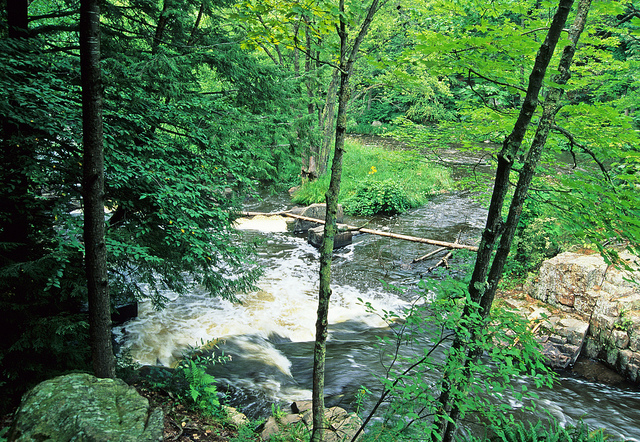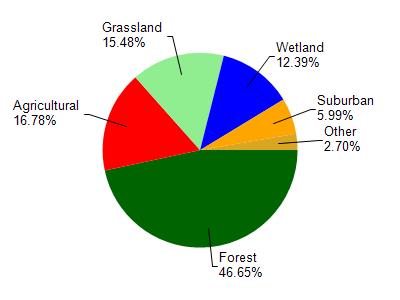
27.45 Miles
0 - 27.45
Warm Mainstem, Cool-Cold Mainstem, Macroinvertebrate, Cool-Cold Headwater, COOL-Warm Mainstem, Coldwater
2025
Excellent
Marathon
No
No
No
Fish and Aquatic Life
Overview
The Eau Claire River is a tributary of the Wisconsin River. It begins at the confluence of the Western and Eastern Branchs of the Eau Claire River in Langdale County and flows generally southwest through Marathon county. It converges with the Wisconsin River just above Schofield, WI.
Date 2011
Author Aquatic Biologist
Historical Description
The old Holtz - Krause Landfill lies within 1,000 feet of Pils, Horseshoe and Cemetery sloughs, all of which are navigable. Pils and Horseshoe sloughs are physically connected to the Eau Claire blowage, which is an impoundment of the Eau Claire River. Contaminated groundwater discharges to these sloughs. Biotic index sampling on the Eau Claire River at different times has shown fair, good and excellent water quality.
In addition, non-metallic mining sites are found along the lower portions of Eau Claire River.
Date 1991
Author Aquatic Biologist
General Condition
The Eau Claire River was assessed during the 2018 listing cycle; new biological (macroinvertebrate Index of Biotic Integrity (IBI) scores) sample data were clearly below the 2018 WisCALM listing thresholds for the Fish and Aquatic Life use. This water was meeting this designated use and was not considered impaired.
Date 2017
Author Ashley Beranek
Condition
Wisconsin has over 84,000 miles of streams, 15,000 lakes and milllions of acres of wetlands. Assessing the condition of this vast amount of water is challenging. The state's water monitoring program uses a media-based, cross-program approach to analyze water condition. An updated monitoring strategy (2015-2020) is now available. Compliance with Clean Water Act fishable, swimmable standards are located in the Executive Summary of Water Condition in 2018. See also the 'monitoring and projects' tab.
Reports
Management Goals
Wisconsin's Water Quality Standards provide qualitative and quantitative goals for waters that are protective of Fishable, Swimmable conditions [Learn more]. Waters that do not meet water quality standards are considered impaired and restoration actions are planned and carried out until the water is once again fishable and swimmable
Management goals can include creation or implementation of a Total Maximum Daily Load analysis, a Nine Key Element Plan, or other restoration work, education and outreach and more. If specific recommendations exist for this water, they will be displayed below online.
Monitoring
Monitoring the condition of a river, stream, or lake includes gathering physical, chemical, biological, and habitat data. Comprehensive studies often gather all these parameters in great detail, while lighter assessment events will involve sampling physical, chemical and biological data such as macroinvertebrates. Aquatic macroinvertebrates and fish communities integrate watershed or catchment condition, providing great insight into overall ecosystem health. Chemical and habitat parameters tell researchers more about human induced problems including contaminated runoff, point source dischargers, or habitat issues that foster or limit the potential of aquatic communities to thrive in a given area. Wisconsin's Water Monitoring Strategy was recenty updated.
Grants and Management Projects
Monitoring Projects
| WBIC | Official Waterbody Name | Station ID | Station Name | Earliest Fieldwork Date | Latest Fieldwork Date | View Station | View Data |
|---|
| 1437600 | Eau Claire River | 10040145 | Eau Claire River 0.3mi SE of Red Granite Rd | 9/26/2013 | 1/1/2015 | Map | Data |
| 1437600 | Eau Claire River | 373182 | Eau Claire River at Badger Road | 10/24/1990 | 5/30/1991 | Map | Data |
| 1437600 | Eau Claire River | 373183 | Eau Claire River at Ross Ave At Kelly WI | 10/24/1990 | 1/1/2015 | Map | Data |
| 1437600 | Eau Claire River | 373373 | Eau Claire River at Cth Y | 5/1/1979 | 1/22/1990 | Map | Data |
| 1437600 | Eau Claire River | 10040657 | Eau Claire River at HWY 52 | 6/25/2013 | 1/1/2015 | Map | Data |
| 1437600 | Eau Claire River | 10012286 | Eau Claire River - Eau Claire River At Camp Phillips Rd | 5/30/2006 | 9/13/2018 | Map | Data |
| 1437600 | Eau Claire River | 10028972 | Eau Claire River at CTH Z | 8/12/2008 | 7/30/2025 | Map | Data |
| 1437600 | Eau Claire River | 373371 | Eau Claire River at Cth Ss | 5/1/1979 | 10/1/1979 | Map | Data |
| 1437600 | Eau Claire River | 10051123 | Eau Claire River - Apache Lane - DC Everest School District Forest | | | Map | Data |
| 1437600 | Eau Claire River | 10040948 | Eau Claire River US Clubhouse Rd | 8/15/2013 | 1/1/2015 | Map | Data |
| 1437600 | Eau Claire River | 373372 | Eau Claire River at Cth N | 5/1/1979 | 1/22/1990 | Map | Data |
|

Watershed Characteristics
Eau Claire River is located in the Lower Eau Claire (Marathon Co.) River watershed which is 172.75 mi². Land use in the watershed is primarily forest (46.70%), agricultural (16.80%) and a mix of grassland (15.50%) and other uses (21.10%). This watershed has stream miles, lake acres and 7,617.54 wetland acres.
Nonpoint Source Characteristics
This watershed is ranked Medium for runoff impacts on streams, Medium for runoff impacts on lakes and High for runoff impacts on groundwater and therefore has an overall rank of High. This value can be used in ranking the watershed or individual waterbodies for grant funding under state and county programs.However, all waters are affected by diffuse pollutant sources regardless of initial water quality. Applications for specific runoff projects under state or county grant programs may be pursued. For more information, go to surface water program grants.
Eau Claire River is considered a Warm Mainstem, Cool-Cold Mainstem, Macroinvertebrate, Cool-Cold Headwater, COOL-Warm Mainstem, Coldwater under the state's Natural Community Determinations.
Natural communities (stream and lake natural communities) represent model results and DNR staff valiation processes that confirm or update predicted conditions based on flow and temperature modeling from historic and current landscape features and related variables. Predicated flow and temperatures for waters are associated predicated fish assemblages (communities). Biologists evaluate the model results against current survey data to determine if the modeled results are corect and whether biological indicators show water quaity degradation. This analysis is a core component of the state's resource management framework. Wisconsin's Riverine Natural Communities.
Warm Mainstem waters are moderate-to-large but still wadeable perennial streams with relatively warm summer temperatures. Coldwater fishes are absent, transitional fishes are common to uncommon, and warm water fishes are abundant to common. Headwater species are common to absent, mainstem species are abundant to common, and river species are common to absent.
Cool (Cold-Transition) Mainstem streams are moderate-to-large but still wadeable perennial streams with cold to cool summer temperatures. Coldwater fishes are common to uncommon, transitional fishes are abundant to common, and warm water fishes are uncommon to absent. Headwater species are common to absent,
mainstem species are abundant to common, and river species are common to absent.
Cool (Cold-Transition) Headwaters are small, usually perennial streams with cold to cool summer temperatures. Coldwater fishes are common to uncommon (<10 per 100 m), transitional fishes are abundant to common, and warm water fishes are uncommon to absent. Headwater species are abundant to common, mainstem species are common to absent, and river species are absent.